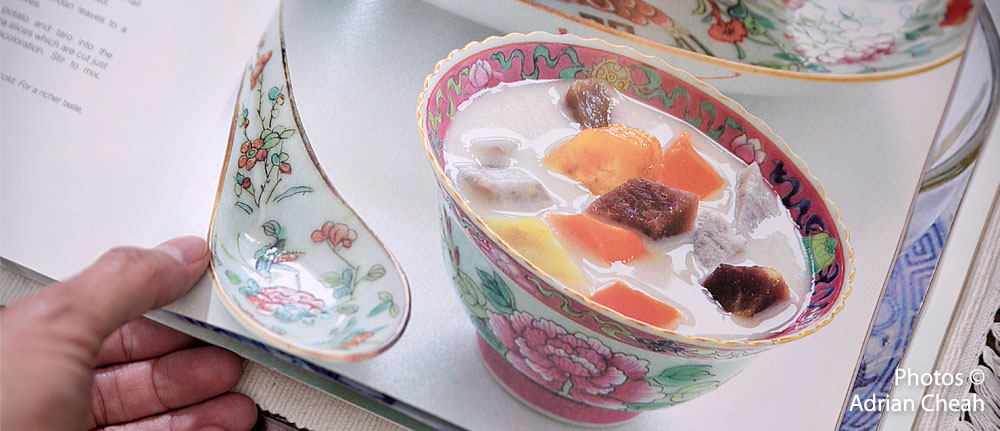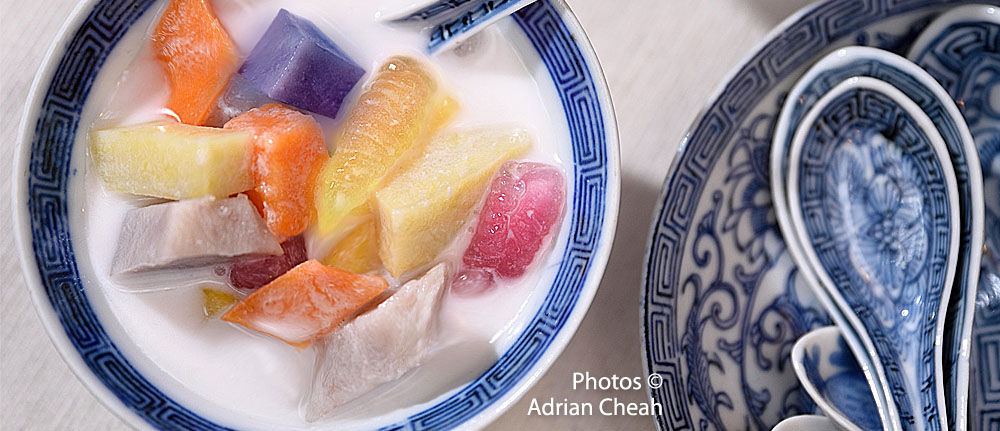The colourful bubur cha cha and pengat – almost similar yet different

In Malay, “bubur” means “porridge”. As "cha cha" is a homophonic with the Hokkien "che che" (meaning "abundance"), it is a dish synonymous with unity and happiness in abundance. Although there are various theories, there is no one definitive consensus on its origin or what the name of the dish actually means.

Bubur cha-cha, a colourful sweetened coconut milk offering, contains a medley of sweet potatoes (of three colours – yellow, orange and purple), taro and tapioca flour jelly, perfumed with aromatic pandan (screwpine) leaves. Nowadays, some would add black-eyed peas and sago pearls into the dish as well, although the traditional version does not have the latter.

In Penang, it is a popular local dessert which is truly rich and delicious. Commonly sold by street vendors at market areas, hawker centres and some restaurants available all year round, served warm or chilled.

A small portion should suffice, thus a petite Straits Chinese porcelain bowl is just the right size to serve a helping. Too much of a good thing will leave one feeling "jelak" (a colloquial Malay term for bored/tired adopted into the Penang Chinese Peranakan cannon of Malay words).
On the other hand, pengat (or pungat) is a traditional festive offering prepared by the Penang Nyonyas for the Chap Goh Meh (15th day of the Chinese New Year) celebration. It is a sweet offering for the gods and ancestors at the altar, concluding the end of the festivities. The dish is almost similar to bubur cha cha except that it contains caramelised bananas (almost invariably, pisang raja). The banana slices give an extra oomph to this dish.
Some people believe that the difference between the two dishes is the shape of how the root vegetables are cut. In my household, for as long as I can remember, all of the sweet potatoes and taro are cut into diamond shapes. I can still vividly remember my late father being entrusted with the duty of cutting the vegetables – patiently slaving away to get all as uniform as possible. Some traditionalists however insist that for pengat, the sweet potatoes must be cut into rectangles.
Some would say that the coconut gravy for pengat is much thicker than that for bubur cha cha. Since the pisang raja is cooked with sugar to caramelise it, this would thicken the gravy somewhat. To me, a good coconut sauce has to be lemak (rich) and creamy, never diluted and of course, pristine white for both pengat and bubur cha cha.
In some instances, gula melaka (palm sugar) is added to sweeten the sauce but this would stain its colour, turning it into an unappetising beige. Since the dish uses fresh santan (coconut milk), be sure to incorporate a pinch of salt to enhance its 'lemakness'. If feasible, refrain from using commercially preserved coconut milk commonly found in boxes. Once the sauce comes to a boil, turn off the fire immediately to prevent the santan from breaking down and releasing oil (pecah minyak). This dessert is best enjoyed when freshly made and should not be kept for days in the fridge.
Although pengat is prepared one day in the year for the auspicious Chap Goh Meh, I would cook it when I come across a batch of beautiful sweet potatoes and pisang raja.
If you ask different people, they would give you different definitions of the pengat and bubur cha cha. In some recipes, black-eyed peas are only used in pengat. Some would even add ti kuih (caramelised glutinous rice cake) to pengat. This however is never the case in my household.
To me, the ingredients in a dish should harmonise well, offering balanced flavours and exciting textures. We must stop listening to hardcore traditionalists and not be shackled by their beliefs and symbolisms in the ingredients that must be used. Thus, I would say, anything goes, according to your own desires. Be adventurous and you could be pleasantly surprised by new discoveries. This is something the Nyonyas have always prided themselves on – their ingenuity and willingness to experiment with flavours – leading to their culinary prowess.
Useful tips in preparing some of the ingredients

Blanch all the sweet potatoes and taro separately until cooked. Test with a fork for doneness. Only assemble the ingredients prior to serving. This would prevent the purple sweet potato from staining the beautiful white sauce. I find this is also the best way to preserve the texture of each ingredient.
For the translucent tapioca jellies, the trick to preparing them successfully is to add boiling water to the tapioca starch and mix together to form a dough. It is important that the ratio of water to tapioca starch is correct; otherwise you will end up with a gummy mess. Divide the dough into separate portions and add food colouring of your choice. Roll it out and cut diagonally into diamond shapes. Boil the pieces till cooked (when they float to the surface), remove and plunge them into cold water. These tapioca jellies add colour and provide a chewy texture to the dish.
As for cooking the sago pearls (opt for the small version), ensure that enough water is used to prevent them from sticking together. The ratio of water to sago should be 10 to 1 and the sago pearls should only be added into boiling water, never at room temperature water as they would dissolve. Remove it from the heat and intermittently stir the sago pearls from time to time. It may seem strange to cook the pearls this way, but this is an optimum way to obtain a perfect chewy texture in the sago.
When all ingredients are ready, cook the santan gravy and assemble the dish. Tuck in and enjoy.


Check out the internet and cookbooks for recipe that will suit you.
Similarities among various desserts in Asia
The creative Penang Nyonyas must have adopted the traditional Malay dessert called pengat pisang (banana broth with a thick santan sauce), adding a multitude of ingredients, making it a more colourful and vibrant offering. There are also other Malay variations like pengat chempedak, pengat labu (pumpkin) and even pengat durian. However the final product is never a colourful ensemble like that achieved by the Nyonyas. The Nyonyas must have then created bubur cha cha from pengat (sans any suffix), removing bananas from the dish.
Throughout Asia, bubur cha cha shares many similarities among various desserts in the region. This include ginatsang bilo bilo, sampelot, binignit and guinatan in the Philippines, naab vaam in Thailand as well as taro and sweet potato ball dessert in Taiwan.
A closer look at the humble sweet potato


Do you know that sweet potato (Ipomoea batatas (L.) Lam.) belonging to the root vegetable family is rich in Vitamins A, C, and D, as well as calcium and fibre?

Its first appearance dates back to 750 B.C. in Peruvian records although some believe that it was originally domesticated at least 5,000 years ago in tropical America (Austin, 1988; Yen, 1982). In 1492, Columbus brought it to Europe and Portuguese explorers of the sixteenth century took it to Africa, India, Southeast Asia and the East Indies. Since its introduction to the East, the sweet potato has earned a special place in Asian cuisines.
However a finding, published in the Proceedings of the National Academy of Sciences, offers evidence that ancient Polynesians may have interacted with people in South America long before the Europeans set foot on the continent.
Furthermore, in 2018, based on the discovery of 57-million-year-old leaf fossils, scientists in India and the US suggest that the sweet potato family originated in the late Paleocene epoch in the East Gondwana landmass that became part of Asia.

Regardless of how the sweet potato has travelled or grown in our own backyard in Asia, it has somehow made its way into the Penang Nyonya bubur cha cha and pengat, celebrating its colourful presentation. Pengat, an auspicious dessert for the gods, is symbolic in ushering in an abundant year ahead.
-------------------------------------
Written and photographed by Adrian Cheah
© All rights reserved
31 January 2023
-------------------------------------
Austin, D. F. 1988. The taxonomy, evolution and genetic diversity of sweet potatoes and related wild species. In P. Gregory (ed.) Exploration, Maintenance and Utilization of Sweet Potato Genetic Resources. CIP, Lima, Peru, pp. 27–60.
Yen, D. E. 1982. Sweet potato in historical perspective. In R. L. Villareal and T. D. Griggs (eds.) Sweet Potato: Proceedings of the First International Symposium. AVRDC, Tainan, Taiwan, pp. 17–30.